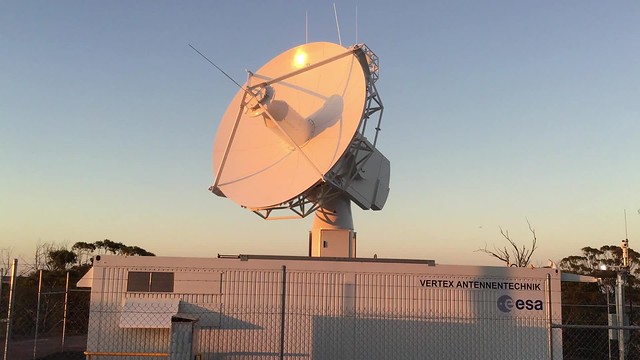Accept all cookies Accept only essential cookies See our Cookie Notice

About ESA
The European Space Agency (ESA) is Europe’s gateway to space. Its mission is to shape the development of Europe’s space capability and ensure that investment in space continues to deliver benefits to the citizens of Europe and the world.
Highlights
ESA - United space in Europe
This is ESA ESA facts Member States & Cooperating States Funding Director General Top management For Member State Delegations European vision European Space Policy ESA & EU Space Councils Responsibility & Sustainability Annual Report Calendar of meetings Corporate newsEstablishments & sites
ESA Headquarters ESA ESTEC ESA ESOC ESA ESRIN ESA EAC ESA ESAC Europe's Spaceport ESA ESEC ESA ECSAT Brussels Office Washington OfficeWorking with ESA
Business with ESA ESA Commercialisation Gateway Law at ESA Careers Cyber resilience at ESA IT at ESA Newsroom Partnerships Merchandising Licence Education Open Space Innovation Platform Integrity and Reporting Administrative Tribunal Health and SafetyMore about ESA
History ESA Historical Archives Exhibitions Publications Art & Culture ESA Merchandise Kids Diversity ESA Brand CentreLatest
Space in Member States
Find out more about space activities in our 23 Member States, and understand how ESA works together with their national agencies, institutions and organisations.
Science & Exploration
Exploring our Solar System and unlocking the secrets of the Universe
Go to topicAstronauts
Missions
Juice Euclid Webb Solar Orbiter BepiColombo Gaia ExoMars Cheops Exoplanet missions More missionsActivities
International Space Station Orion service module Gateway Concordia Caves & Pangaea BenefitsLatest
Space Safety
Protecting life and infrastructure on Earth and in orbit
Go to topicAsteroids
Asteroids and Planetary Defence Asteroid danger explained Flyeye telescope: asteroid detection Hera mission: asteroid deflection Near-Earth Object Coordination CentreSpace junk
About space debris Space debris by the numbers Space Environment Report In space refuelling, refurbishing and removingSafety from space
Clean Space ecodesign Zero Debris Technologies Space for Earth Supporting Sustainable DevelopmentLatest
Applications
Using space to benefit citizens and meet future challenges on Earth
Go to topicObserving the Earth
Observing the Earth Future EO Copernicus Meteorology Space for our climate Satellite missionsCommercialisation
ESA Commercialisation Gateway Open Space Innovation Platform Business Incubation ESA Space SolutionsLatest
Enabling & Support
Making space accessible and developing the technologies for the future
Go to topicBuilding missions
Space Engineering and Technology Test centre Laboratories Concurrent Design Facility Preparing for the future Shaping the Future Discovery and Preparation Advanced Concepts TeamSpace transportation
Space Transportation Ariane Vega Space Rider Future space transportation Boost! Europe's Spaceport Launches from Europe's Spaceport from 2012Latest

First contact
Thank you for liking
You have already liked this page, you can only like it once!
Ariane 5 flight VA229 lifted off yesterday morning at 05:20 GMT (02:20 local time, 06:20 CET) from Europe’s Spaceport in Kourou, French Guiana, to deliver a telecom satellite into geostationary orbit.
Just 40 minutes later, in its first operational usage, ESA’s new 4.5 m-diameter antenna located in Western Australia swung into action, acquiring signals from the launcher arcing high overhead, delivering Eutelsat-65 West A into its planned transfer orbit.
The antenna, installed in 2015 and inaugurated last month, maintained a link until the rocket flew out of visibility at a range of about 22 000 km some 80 minutes later.
The small antenna was used to ‘slave’ point ESA’s much larger 35 m-diameter antenna, both at the New Norcia ground station, which could also then acquire telemetry from Ariane.
Yesterday’s tracking support was the first operational usage of the antenna and demonstrated its full capabilities in a crucial, realtime assignment.
“The antenna had previously ‘shadow’ tracked LISA Pathfinder in December 2015, but that was only to test its new systems, while another ground station was simultaneously available to take over if any problems had arisen,” says ground station engineer Peter Droll.
“This time, there was no back-up, so everything had to work perfectly, and it did.”
The new antenna will be used for tracking rockets and communicating with newly launched satellites, taking advantage of the ideal location under the flight paths of launchers departing from Kourou.
Its advanced technology allows it to quickly and precisely lock onto and track satellites during their critical first orbits, up to roughly 100 000 km out, as well as Europe’s Ariane 5, Vega and Soyuz rockets.
More information
Video via Flickr

New antenna ready for business
-
CREDIT
D. Hamilton -
LICENCE
ESA Standard Licence














 Germany
Germany
 Austria
Austria
 Belgium
Belgium
 Denmark
Denmark
 Spain
Spain
 Estonia
Estonia
 Finland
Finland
 France
France
 Greece
Greece
 Hungary
Hungary
 Ireland
Ireland
 Italy
Italy
 Luxembourg
Luxembourg
 Norway
Norway
 The Netherlands
The Netherlands
 Poland
Poland
 Portugal
Portugal
 Czechia
Czechia
 Romania
Romania
 United Kingdom
United Kingdom
 Slovenia
Slovenia
 Sweden
Sweden
 Switzerland
Switzerland





























